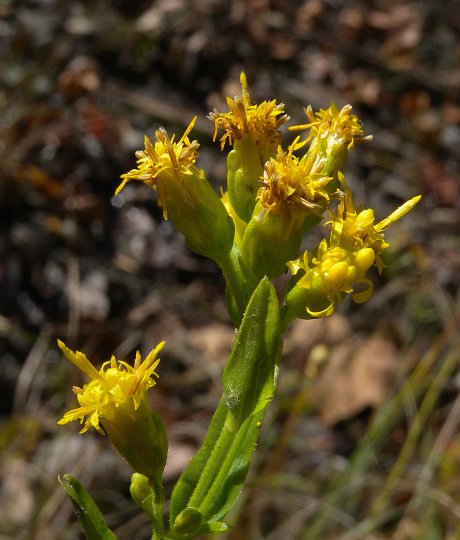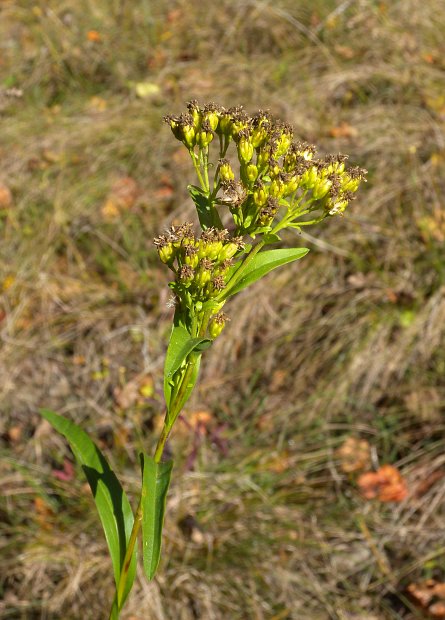
Each flowerhead in the panicle is about ¼" across and similarly long; it has 4-9 ray florets that surround 5-10 disk florets. The widely spreading petaloid rays of each flowerhead are yellow and short-oblong in shape; they sometimes curl downward. The corollas of the disk florets are yellow and short-tubular in shape with 5 ascending to spreading lobes. Both ray florets and disk florets are perfect. Surrounding the base of each flowerhead, there small floral bracts (phyllaries) in 3-5 series that are appressed together. These floral bracts are light green to greenish yellow, oblong in shape, and they have vertical solitary nerves in the center. The blooming period occurs from early to mid-autumn for about 3 weeks. Afterwards, the florets are replaced by achenes with sessile tufts of white hair. These achenes are 1.5–2 mm. long, bullet-shaped, slightly flattened, and vertically ribbed. The root system consists of a thickened rootstock with fibrous roots – on older plants, the rootstock may form a caudex. Sometimes rhizomes are also produced, forming clonal offsets.
Cultivation: This goldenrod prefers full sun, wet to moist conditions, and calcareous soil containing some sand or gravel. A steady supply of moisture is required, especially during hot dry weather. New plants can be started from seeds or by division of rhizomes.
Range & Habitat: The native Riddell's Goldenrod (Oligoneuron riddellii) is uncommon to occasional in NE Illinois, while in the rest of the state it is rare or absent (see Distribution Map). This goldenrod is found primarily in the Upper Midwest and adjacent areas of Canada. Habitats include moist dolomite prairies, gravelly hillside seeps, fens, and low areas along springs. This goldenrod occurs in higher quality wetland habitats.

Faunal Associations: Many insects visit the flowers of goldenrods (Solidago spp., Oligoneuron spp., Euthamia spp.) for nectar and pollen, including long-tongued bees, short-tongued bees, wasps, flies, and beetles. Tuell et al. (2008) observed honeybees, bumblebees, little carpenter bees (Ceratina spp.), long-horned bees (Melissodes spp.), Halictid bees, masked bees (Hylaeus spp.), and Andrenid bees visiting the flowers of of Riddell's Goldenrod (Oligoneuron riddellii); their observations were restricted to bees. Other insects feed destructively on the leaves, plant juices, flowerheads, and other parts of goldenrods. These insect feeders include both the larvae and adults of leaf beetles (Microrhopala spp., Ophraella spp., Trirhabda spp.), the larvae of leaf-mining flies (Calycomyza spp.), the larvae of gall flies (Asteromyia spp.), plant bugs (Lygus spp., Plagiognathus spp., Polymerus spp., Slaterocoris spp.), stink bugs (Euschistus spp.), aphids (Uroleucon spp.), treehoppers (Stictocephala spp.), the larvae of twirler moths (Gelechiidae), the larvae of Geometer moths, the larvae of owlet moths (Noctuidae), and the larvae of Tortricid moths; see Clark et al. (2004), Spencer & Steyskal (1986), Felt (1917), Aldrich & Osten-Sacken (1905), Knight (1941), Wheeler et al. (1983), Watson (1928), Rider (2009), Blackman & Eastop (2013), Hottes & Frison (1931), Dennis (1952), Loeffler (1994), Covell (1984/2005), Wagner (2005), and Miller (1987). Some upland gamebirds, such as the Greater Prairie Chicken and Ruffed Grouse, feed on the leaves and flowerheads of goldenrods, while such songbirds as the Eastern Goldfinch, Indigo Bunting, Slate-colored Junco, Swamp Sparrow, and Tree Sparrow feed on the seeds (Yeatter, 1943; DeVore et al., 2004; Martin et al., 1951/1961). Muskrats and beavers sometimes feed on the stems or use the stems of wetland goldenrods in the construction of their dams and/or lodges. White-tailed Deer, Cottontail Rabbits, and Meadow Voles sometimes feed on the foliage (Martin et al., 1951/1961; Sotala & Kirkpatrick, 1973), as do domesticated livestock when they have access to such plants.

Photographic Location: A gravelly hillside seep at Turkey Run State Park in west-central Indiana.
Comments: There is some disagreement among taxonomists on how Riddell's Goldenrod and other flat-headed goldenrods should be classified. Following Mohlenbrock (2013), these goldenrods have been assigned to the Oligoneuron genus, rather than the Solidago genus of the more typical goldenrods. One reason for this is that Riddell's Goldenrod and other flat-headed goldenrods can hybridize with each other, but not with other goldenrods. Riddell's Goldenrod (Oligoneuron riddellii) resembles Ohio Goldenrod (Oligoneuron ohioense), but they can be distinguished from each other as follows: 1) Ohio Goldenrod blooms about a month earlier than Riddell's Goldenrod in any given area, 2) the alternate leaves of Riddell's Goldenrod are strongly arching, while the alternate leaves of Ohio Goldenrod don't arch significantly, 3) the alternate leaves of Ohio Goldenrod have minute serrated teeth, while the alternate leaves of Riddell's Goldenrod are toothless along their margins, and 4) the alternate leaves of Riddell's Goldenrod are conspicuously folded along their midveins, while those of Ohio Goldenrod are relatively flat. Riddell's Goldenrod sometimes hybridizes with Oligoneuron rigidum (Stiff Goldenrod) and Oligoneuron album (White Goldenrod) when they grow in proximity to each other.